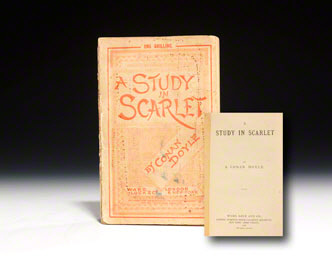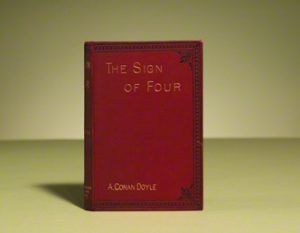In 1882, a young doctor waited for patients to arrive. To pass the time, he began writing short stories.
The man named Arthur Conan Doyle later became embarrassed by these early efforts.
There was a time in my life which I divided among my patients and my literature…It is hard to say which suffered most.
Nevertheless he successfully sold a number of short stories—enough at least to retain his optimism in continuing the craft. After a few years he turned to the novel form.
His first novel-length manuscript was the largely autobiographical Narrative of John Smith, which he proudly sent off to a publisher for assessment. It was lost in the mail. He had only one copy.
His second novel, The Firm of the Girdlestone, was sent to multiple publishers (this time with multiple copies!) and immediately rejected. He shelved it.
Then in 1886 Conan Doyle introduced two new characters in a book he tentatively named A Tangled Skein. After little over a month of writing, his characters Sherrinford Holmes and Ormond Sacker had become Sherlock Holmes and Dr. Watson, and the book renamed A Study in Scarlet.
Conan Doyle famously took his inspiration for the iconic Holmes from an old teacher, Dr. Joseph Bell. Disarmingly humble about the association, Dr. Bell once remarked, “Dr. Conan Doyle has, by his imaginative genius, made a great deal out of very little.”
A Study in Scarlet was sent to four publishers before Conan Doyle received his first offer. It was not a flattering one—they offered to pay him £25 for the copyright, less than he had received for significantly shorter pieces in the past.
While the publication of Scarlet turned out to be rather unmemorable, folded into a one-shilling Christmas annual, the work did eventually reach publication in book -form. For those who love trivia, A Study in Scarlet has a good tidbit. The first printing in book form was illustrated with six pen-and-ink drawings by Conan Doyle’s father Charles Doyle—a talented artist who had been committed to a lunatic asylum by his family because of advanced alcoholism and epilepsy. According to Conan Doyle biographer Daniel Stashower, Charles Doyle spent his life believing himself unjustly confined.
Interestingly enough, Conan Doyle did not consider Scarlet the big breakthrough of this career. He argued, in fact, that the great turning point of his career came that same year when he wrote an English translation of a German article, “Testing Gas Pipes for Leakage.” It was the first time a publisher commissioned him to write a piece, rather than him approaching the publisher. It wasn’t until the 1889 that Conan Doyle was offered money up front for a Sherlock Holmes piece: the novel The Sign of Four.




Comments
12 Responses to “The Story Behind the First Sherlock Holmes Novel: A Study in Scarlet”
Steve Clancy says: September 4, 2013 at 5:32 pm
True history is always stranger and more surprising than fiction!
cosmoglaut says: September 4, 2013 at 11:39 pm
I was under the impression that the two characters were originally called Sherrinford Holmes/Sheridan Hope (who became Sherlock Holmes) and Ormond Sacker (who became John H Watson).
And it’s wonderful to know that ACD’s father illustrated the first edition!
Rebecca Romney says: September 6, 2013 at 9:12 pm
I’m not sure about the Sacker character. I referenced Stashower’s biography Teller of Tales for that tidbit.
As for Charles Doyle, another interesting fact is that ACD felt his father’s talent was unfairly unrecognized and tried to support it as much as possible.
Rebecca Romney says: September 10, 2013 at 10:05 pm
An update: I’ve referenced a number of other sources for this and the Sacker tidbit appears to be correct. Thank you for bringing to my attention; I’m updating my post to reflect correct information.
Jon Arauji says: September 6, 2013 at 12:32 am
This is fascinating. I’ve read every Sherlock Holmes story and novel and I believe Conan Doyle’s works are largely responsible for how popular detective mysteries have become in the last 100+ years. What do you think about his early efforts that were rejected? Are there any known copies of either novel?
Rebecca Romney says: September 6, 2013 at 9:15 pm
Scholars generally feel that his early work tends to be rather derivative. He once published a piece anonymously and readers believed it was by Robert Louis Stevenson. Flattering for a new writer, yes, but derivative. Later in life ACD would ruefully remark that he was glad his first manuscript was lost in the mail because it was horrible.
For an early work non-Holmes work that ACD was particularly proud of, I’d recommend The White Company (1891).
Also, don’t forget Poe’s importance in the creation of the modern mystery! Certainly ACD advanced it further, but Poe should not be overlooked.
Jon Arauji says: September 6, 2013 at 10:49 pm
Very interesting, I’ll certainly check that book out. And I didn’t want to take anything away from Poe, I love the Murders in the Rue Morgue, the way he brought to life the deductive powers of Dupin made it an incredible read. You can certainly see some similarities between Dupin and Holmes.
James says: December 21, 2013 at 9:09 am
For those interested, in 2011 the British Library published a version of The Narrative of John Smith, not from the original manuscript (which, as Rebecca noted, was lost in the mail) but from an unfinished manuscript they acquired in 2004 and which, they claim, was likely reconstructed from memory by ACD following the loss of the original. I have the book here, but haven’t read it yet so I can’t attest to its quality. Still, an interesting read even if only from a historical perspective!
Joe says: September 12, 2013 at 11:10 pm
Hi Rebecca- I have the limited edition facsimile printed by Dr. Watson books 1993 No. 092 of 100. Purchased from a collector across the pond. I love this book.
I also collect US pirated editions of Doyle works.
Joe says: September 12, 2013 at 11:17 pm
Who could forget Dipin…
Joe says: September 12, 2013 at 11:17 pm
Dupin.. sorry.
Retelise says: March 2, 2019 at 7:31 am
Can you clarify exactly which name was proposed before ACD finally settled on Sherlock Holmes
Thank you